Introduction: This article by Tom Hambright on the cable history of Key West was first published in the Fall 1991 issue of Florida Keys Sea Heritage Journal.
Mr Hambright is Historian at the Key West Library; the article is reproduced here by his kind permission and is copyright © 2010 by Tom Hambright. |
| --Bill Burns |
KEY WEST & CUBA BECOME LINK FOR INTERNATIONAL COMMUNICATIONS
INTERNATIONAL OCEAN TELEGRAPH CO. IN KEY WEST
For the first time, the United States is directly connected to a foreign country through underwater cable. This an account of Key West’s important role in a major historical event.
By Tom Hambright
In today’s information age, it is easy to forget that electrical communication is less than 150 years old. In 1844, Samuel Morse built the first telegraph line from Baltimore to Washington. A test of an underwater cable the next year in Portsmouth, England, proved an underseas cable was possible.
The underwater cable required a different electrical insulator than in use at that time. The answer was Gutta Percha, a rubber-like substance from the tree of the same name. The only liability was the Gutta Percha would become soft and pliable in warm air. Underwater storage solved this problem.
A submarine cable between England and France in 1849 proved international communication practical. The American Civil War had delayed the development of underseas cable in this country. At the end of the war, entrepreneurs, seeing a potential market, moved to organize submarine cable companies.
Businessmen James A. Scrymser and Alfred Pell, Jr. incorporated the International Ocean Telegraph Co. (IOTC) on Dec. 2, 1865. The line was to connect the United States and Cuba and, eventually, Central and South America and the Caribbean. The president of the new company was former Union General William F. “Baldy” Smith. The company obtained exclusive landing rights from the United States Government, the Spanish Government and the State of Florida. In addition, Congress passed a law authorizing all telegraph companies to place lines on federal public domain and on military and post roads, as well as giving the companies the right to take necessary “stone, timber, and other materials for its posts, piers, stations and other needful uses.” The State of Florida gave the company the right “to construct and maintain their Telegraphic Lines over the Internal Improvement and Swamp lands of Florida without charge during the existence of said Company.”
The IOTC began construction of the land line from Lake City to Punta Rassa in the spring of 1867 and completed the work on May 29. From Lake City, north the messages would travel by Western Union Telegraph Co. lines.
The India Rubber, Gutta Percha and Telegraph Works Co. of England manufactured the submarine cable. The 1,200-ton schooner-rigged screw steamer, Narva, carried the cable from England and was the cable layer. The United States steamer, Tahoma, the lighthouse steamer, Fountain, and the Spanish war steamer, Francisco de Asis, assisted the Narva.
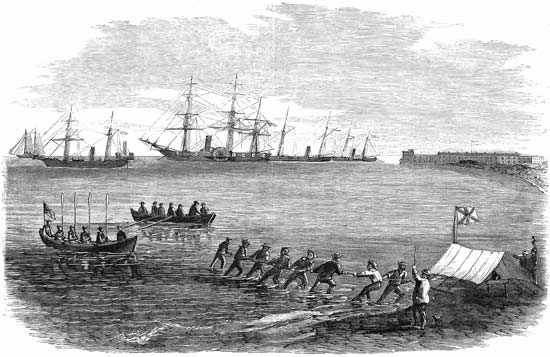
The Cuban Cable - Landing the Shore End at South Beach,
near Fort Taylor, Key West. - sketched by Dr. J.B. Holder.
Harper's Weekly, 7 September 1867 |
The underwater work began with the landing of the shore end of the cable at Key West on Aug. 3. The next day, the Narva laid the cable to the south of Sand Key and then cut and buoyed the end. The Narva then sailed to Havana and landed the other shore on Aug. 5. The next day, the Narva sailed north to Key West paying out cable at about the rate of 3½ miles per hour to connect with the Key West shore end. Weather and navigation problems delayed the splicing of the Cuban cable and Sand Key end until August 18.
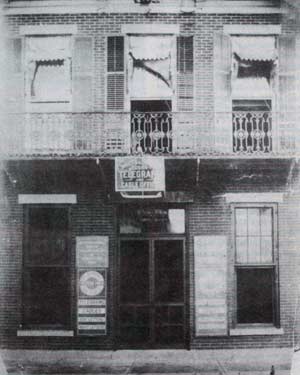
The International Ocean Telegraph / Western Union Office at 416 Greene Street, Key West, circa early 1900s.
Image courtesy Monroe County Library. |
On Aug. 21, E.O. Gwynn, mayor of Key West, and Joaquin del Manzano, captain-general of Cuba exchanged telegrams. The Narva had brought yellow fever to Key West. This delayed the completion of the mainland connection until Sept. 10. On Sept. 11, 1867, Secretary of State William H. Seward and Captain-General Joaquin del Manzano exchanged greetings.
The cable landed in Key West near the bridge at Ft. Zachary Taylor. The cable ran underground to the telegraph office. The location of the first office is not yet known. On the north side of the island, the cable shore connection was at the army barracks, the area now known as Peary Court.
Communication with the outside world was now available, but beyond the means of the average working man. As part of the bill to grant the company an exclusive franchise to Cuba, Congress had limited the cost of a telegram to $3.50 for each 10 words. The company interpreted the limitation to apply only to the undersea cable and by 1870, the charge for a 10 word cable from Havana to Lake City was $4.00 in gold.
The cable did end the isolation Key West had suffered from with irregular mail service. The citizens of Key West arranged to receive daily news service.

1927 Key West - Punta Rassa cable, recovered off Punta Rassa in 2013 |
From the beginning, the IOTC was
a financial success. In 1868, the company added a second cable to handle
the increased traffic. In 1873, the Punta
Rassa-Havana line handled 51,899
messages. This prosperity led to the
giant Western Union acquiring controlling interest in the company that year. The IOTC was to remain a subsidiary until Western Union absorbed it in 1957. Also constructed in 1873 was the new Key West office at 416 Greene St.
The IOTC added and replaced cables over the years as required for traffic or the old lines failed. The Key West-Havana cable added new lines in 1873 and 1917. The Key West-Punta Rassa cable added new lines in 1871, 1875, 1890, and 1927. The latter was a two channel cable [see illustration to the right]. The 1890 line included a station at Sanibel Island. The company discontinued the Sanibel station in 1927. In 1899, the IOTC completed a Key West-Miami cable. This was a three channel cable. After 1927, the company had three single channel cables to Havana, one dual channel cable to Punta Rassa and one three channel cable to Miami. The company abandoned the Punta Rassa cable after World War II.
The cable hut next to the Southernmost Point monument on Whitehead Street was part of the 1917 cable. This provided connections to link the undersea cable to the land line. The northern connection and cable hut was on the railroad property, the area now known as Hilton Haven.
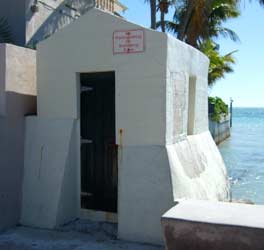
1917 cable hut,
January 2010
Photo: Bill Burns |
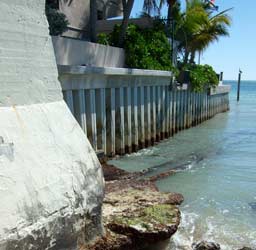
Detail of shore-end cables
Photo: Bill Burns |
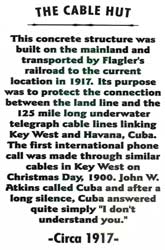
Historic Marker
Photo: Richard Weil |
The Cable Hut
This concrete structure was built on the mainland and transported by Flagler’s railroad to the current location in 1917. Its purpose was to protect the connection between the land line and the 125 mile long underwater telegraph cable lines linking Key West and Havana, Cuba. The first international phone call was made through similar cables in Key West on Christmas Day, 1900. John W. Atkins called Cuba and after a long silence, Cuba answered quite simply “I don't understand you.”
-Circa 1917- |
The location of the storage tanks, needed to keep the Gutta Percha cable underwater, has changed over the years. The first tanks were at Philbrick’s Wharf, where the A & B Lobster House is today. The next tanks were at William Curry & Son’s Wharf, today the site of the Hyatt and Galleon. Next the site of the storage tanks was the Florida East Coast Railroad yard at Trumbo Point. When the Navy took over Trumbo Point at the beginning of World War II, the IOTC solved its storage problem by using the ocean floor north of Smith Shoals Lighthouse.
American Telephone and Telegraph Co. (AT&T) built the cable storage tanks on Mallory Docks. The tanks were needed to support the underwater telephone lines to Cuba. AT&T built the first tank in the early 1920’s when the first phone line to Cuba opened and built the second in 1930 to support the six channel telephone cable laid that year.
The first superintendent of the cable was W.H. Heiss. Heiss had supervised the construction of the land line to Punta Rassa. In 1873, when Western Union took control of IOTC, N. DeBree replaced Heiss as superintendent. In 1888, Martin Hellings became cable manager in Key West. Prior to and during the Spanish American War, he operated an intelligence service for the U.S. Government. Havana telegrapher, Domingo Villaverde, whose office was in the Governor General’s Palace, supplied the information to the Key West station. Hellings was then able to provide the White House War Room with the latest news from Cuba. When the war started, Hellings became a captain in the U.S. Army Volunteer Signal Corp. He retired from IOTC in 1906.
John W. Atkins became manager upon Hellings' retirement. In addition, he was a noted ornithologist and his work added two birds to the fauna of North America. Atkins retired in 1929.
Capt. G.R. Steadman became the next cable manager and captain of the cable repair schooner, John W. Atkins. He began working for Western Union in Key West in 1917. Before that he had worked for Florida East Coast Railway running launch boats and building telephone lines to construction camps while the railroad was under construction along the Florida Keys. When the first train came to Key West in 1912, he was on it, riding atop the cow catcher. In 1939, Capt. Steadman took command of the new cable schooner, Western Union. Capt Steadman retired in 1957 after 41½ years with the IOTC.
Capt. Richard (Dick) T. Steadman, his son, started working for Western Union in 1939. He worked out of both the Miami and Key West offices until 1952, when he moved permanently to Key West. When his father retired, Capt. Dick became cable manager and master of the Western Union. In the early 1970’s, the use of satellites and other new technology led Western Union to reduce its cable operations and retire the schooner, Western Union. Capt. Dick Steadman retired July 1, 1973, the last cable manager in Key West.
Tom Hambright is Director of State and Local History for the Monroe County Library. For more history of the International Ocean Telegraph Company, see Canter Brown, Jr.’s article in The Florida Historical Quarterly of October, 1989.
See also:
The Western Union company history page for further information on the International Ocean Telegraph Company.
This detailed contemporary account of the laying of the 1867 cable from Florida to Cuba.
J. Gregory Griffin’s article on the history of the Key West - Havana telephone cables.
The history of cable schooner Western Union. |






